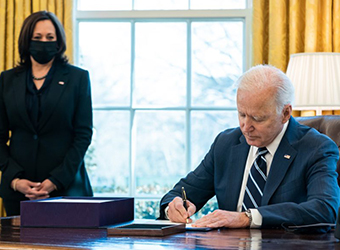On Thursday, March 11, President Joe Biden signed into law the American Rescue Plan Act of 2021, a long-anticipated $1.9 trillion relief package. Although the bill provides hundreds of billions in funding to replenish COVID-19 relief programs and grants established by its predecessor, the 2020 CARES Act, it is best known for its provision that provides millions of Americans with a third stimulus check of up to $1,400. This act comes off the heels of another relief bill, the Coronavirus Response and Relief Supplemental Appropriations Act (CRRSAA), which was signed into law by President Donald J. Trump in late December of 2020.
$40 billion for higher education
Tucked away in Biden’s roughly 600-page American Rescue Plan Act (ARPA) of 2021 is about $40 billion in higher education relief, a whopping $26 billion more than the CARES Act provided. This $40 billion is allocated toward the Higher Education Emergency Relief Fund (HEERF), a pot of funding created in the CARES Act, which provides “institutions of higher education, or IHEs, with support. Allocations follow a formula outlined in the CRRSAA, which prioritizes funding for schools with the largest unmet needs. The formula considers several factors such as the ratio of Pell Grant recipients to non-Pell students, and whether or not the institution received money from the CARES Act. IHEs that receive an allocation from the fund must comply with the following conditions outlined in the American Rescue Plan Act of 2021.
Evidence-Based COVID-19 Precautions
Institutions receiving funds from the HEERF must use a portion of their allocation to implement evidence-based practices and guidelines designed to promote public health by preventing the spread of COVID-19. The bill is not specific as to what exactly these best practices look like and simply requires them to be “evidence-based.” Funds received from the HEERF may not be used for capital projects, meaning that institutions may not fund construction projects with money received.
Student Financial Aid
As in the CARES Act, the bill also stipulates that, of the money allocated to each institution, 50% must go directly to students in the form of emergency financial assistance. Colleges and universities may decide how the money is distributed to students; each may establish their own criteria to prioritize grant distribution, although financial need must be considered. Additionally, the bill requires IHEs to directly contact financial aid applicants about the opportunity to receive financial aid due to the loss of employment of the student, or a family member. Students who receive emergency aid from this fund may apply their grant to just about any COVID-19 related expense including housing, food, mental healthcare, or even tuition.
Tax-Free Student Loan Forgiveness
Although the ARPA does not address student loan forgiveness directly, it clears the path for future proposals by including a provision to make student loan debt forgiveness tax-free from December 2020 through Dec. 31, 2025. President Biden also extended relief for borrowers in an executive order issued in January 2021. The order continues provisions from the CARES Act that were due to expire on January 31, specifically reducing interest to 0% and pausing the collection of defaulted loans.
$91 million to the Department of Education
In addition to the money for higher education, the bill also provides the Department of Education with $91 million. The department earmarked the money to help students assess and apply for the various forms of financial aid that are available to them, including the FAFSA.
Adult Dependent Stimulus
Not only does The American Rescue Plan Act of 2021 provide aid to students through emergency aid grants to colleges and universities, but it also expands stimulus eligibility to include adult dependents for the first time. Adult dependents are at least 17 years of age and are claimed as a dependent by a parent or caretaker on their taxes.
This is an important update for college access and success organizations to be aware of, as many of today’s college students fall in this category and were previously ineligible to receive stimulus payments under the CARES Act and CSSRAA. For an adult dependent to qualify for the stimulus, the person claiming the adult dependent must be eligible for a stimulus payment themselves. This means that the claimant must earn less than $80,000 as a single filer, or less than $160,000 if filing as a married couple. Adult dependents will receive the same amount that the claimant receives, and the IRS will deposit their stimulus check into the claimant’s account. Due to this, adult dependents will have to retrieve the money from their claimant personally.
Child Tax Credits
Also included in the Act are several major changes to the Child Tax Credit that may provide financial relief for families planning their children’s entry into postsecondary education as well as student parents. The scope of the credit has been extended to children in families with low or no earnings, and also covers 17-year-olds. The legislation also raises the maximum credit from $2,000 to $3,000 per child and $3,600 for children under age 6. Several economic thought leaders have suggested that these provisions have the potential to cut child poverty in half. For a deeper analysis of the potential financial impact of the Act, FCAN recommends reading reports from the Center on Budget and Policy Priorities and the Center on Poverty and Social Policy
RELATED ARTICLES:
FAFSA simplification, Pell expansion, emergency aid and other wins from the 2021 omnibus
How the CARES Act can help Florida college students and education institutions

